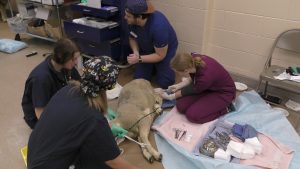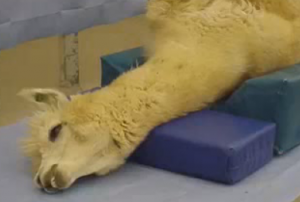Food Animal Drugs
Small ruminant analgesia, sedation and anesthesia
Small ruminants are “minor” species in the food animal regulatory world so you have more leeway but still need to include meat and milk withdrawal information.
NSAIDs
Flunixin and ketoprofen are the only approved NSAIDs in food animal species. Meloxicam is used off label. No products are labeled for sheep and goats.
- Flunixin 1.1mg/kg IV q 12 hours (oral administration is not advisable due to low bioavailability)
- Meloxicam 1mg/kg PO q 24 -48 hours
Meloxicam is gaining in use and the oral form appears to be highly bioavailable. Tablets are crushed and mixed with molasses or other flavoring as otherwise animals will eat around it.
Check FARAD for withholding!
Narcotics and others
Nalbuphine is gaining in popularity as it is typically not a controlled substance (laws do vary by state). It seems to be equally as effective as butorphanol and is cheaper. Subcutaneous nalbuphine (1 mg/kg) resulted in analgesia within 30 minutes in sheep.
Transdermal fentanyl (patch) can provide steady analgesia for 2-3 days.
Gabapentin has been used anecdotally with success for chronic pain management.
Sedation and anesthesia
Small ruminants are typically amenable to dog-like restraint, especially when sick. Light sedation and local blocks can be very effective as long as the animal is pain free. Tracheal intubation is very challenging and requires animals to be at a deeper plane of anesthesia. It is a trade off in the safety of having a tube in place vs the safety of light anesthesia.

Sheep can develop fatal pulmonary edema with xylazine due to the release of prostaglandins and vasoactive substances from pulmonary macrophages. This is a relatively new finding but obviously scary. The risk is highest with general anesthesia and with higher doses given iv. We aren’t sure yet if the problem occurs in goats. Be aware of the risk and try to use other drugs such as the benzodiazepines. If you do have to use xylazine, avoid rapid iv injection and have reversal agents on hand. Detomidine also seems to cause issues in sheep (pulmonary vascular resistance).
For minor procedures:
- midazolam 0.2mg/kg IV + 0.1mg/kg butorphanol IV
- add 2-5 mg/kg ketamine iv or im for longer or more painful procedures
- add xylazine 0.05mg/kg iv but carefully and only if needed
- consider propofol if available
- ketamine stun in goats
- see induction protocol 1 below
- xylazine (goats)
- 0.05-0.1 mg/kg iv
- xylazine (0.2 mg/kg) and ketamine (3 mg/kg): deep sedation for 30 min in goats –but not surgical anesthesia
- butorphanol (0.02 mg/kg iv) and xylazine (0.01-0.02 mg/kg) provide deep sedation and recumbency for 60 minutes in goats
Typical general anesthesia protocols for healthy small ruminants
| Anesthesia | Drug | Dose (mg/kg) | Route |
|---|---|---|---|
| Pre-operative analgesia | Flunixin meglumine | 1.1 mg/kg | Iv |
| Sedative (if needed) | Acepromazine
Detomidine Romifidine |
0.2 mg/kg
0.02-0.04 mg/kg 40-80 ug/kg |
im
im im |
| Induction protocol option 1 | Xylazine | 0.05-0.3 mg/kg | iv |
| Butorphanol | 0.05-.1 mg/kg
0.2 mg/kg |
iv
im |
|
| Ketamine | 0.5-1 mg/kg | Iv | |
| Induction protocol option 2 | Midazolam | 0.1-0.2 mg/kg | Iv |
| Ketamine | 2-5 mg/kg | iv | |
| +/- Butorphanol | 0.1 mg/kg | iv | |
| Maintenance | Redosing, iv infusions, inhalant anesthesia |
Goats can also receive a combination of xylazine (0.05-0.1 mg/kg) im plus ketamine (5-10 mg/kg) im to create a plane of surgical anesthesia for 20-30 min.
Xylazine stimulates urine production and is not ideal in blocked goats unless you can perform cystocentesis or surgery.
Buprenorphine (0.1 mg/kg iv or im) provides good analgesia; morphine provides better analgesia (0.05-0.1 mg/kg iv or im).
Local blocks are good things and can minimize the need for general anesthesia. Remember small ruminants are very sensitive to the toxic effects of lidocaine. Assume maximum dose of 6 mg/kg. Lidocaine can be diluted to extend the reach; this does shorten the duration of numbness.
Obese animals need drug reductions (roughly 15-20% if 5/5) to be dosed appropriately for estimated lean body weight. Remember that the fat layer is thick; intramuscular injections may be just intra-fat injections.
Peri-anesthetic Support
Food should be withheld for 12-18 hours to minimize bloating in adult animals. This applies for both recumbent sedation and general anesthesia (also recumbent). Neonates should not be fasted more than 4 hours. Because of the danger of pregnancy toxemia in late gestation, late pregnant animals should be minimally fasted or carefully supported.
Young small ruminants can become hypothermic; this is usually not a problem in older ruminants.
Hypoventilation and apnea are relatively common. Be prepared to stimulate respiration.
Fluid therapy and supplemental oxygen should be considered for longer procedures.
Due to copious salivation and high risk of regurgitation, animals should be positioned so the head is tilted downward. It can help to elevate the neck, creating a “V” at the poll or withers.

Atropine is not useful in stopping salivation and can be detrimental as it makes the saliva thicker.
Monitoring
Pulse oximetry and other monitoring devices can be very useful in small ruminants. Without these tools, monitoring is challenging and requires careful attention. If in doubt, reduce the anesthetic depth until signs of light anesthesia become apparent.
For most anesthesia, the pupil should be central and moderately constricted. Rotation of the globe is not useful for monitoring and the corneal reflex should be maintained.
Too light
- Mydriasis is observed at a light plane and again at a deep plane.
- Chewing, esophageal activity and limb movement indicates too light of a plane.
- Increased muscle tone (jaw tone)
- Nystagmus
Too deep
- Mydriasis combined with no palpebral reflux is likely a deep plane.
- Decreased muscle tone (jaw tone); some jaw tone persists even at deep planes
- Slowed heart rate
- Shallow or paradoxic respiration (chest contracts during inhalation vs expands)
Recovery
Recovery from anesthesia is usually uneventful. Hypothermia will prolong recovery so animals should be kept warm and dry. Animals should be placed in sternal recumbency and, if used, the endotracheal tube left in position with the cuff inflated until the animal can swallow. Once the animal can cough and swallow the tube can be removed; the cuff can be left inflated during removal if regurgitation occurred.
Resources
In sheep undergoing general anaesthesia does inclusion of medetomidine result in hypoxaemia? Veterinary Evidence, 2025, 10(2). Short answer: yes and it is variable; discusses how to manage
Pain management in small ruminants and camelids: Analgesic agents.Vet Clin North Am Food Anim Pract . 2021 Mar;37(1):1-16.
Field Sedation and Anesthesia of Ruminants, August 2016, Veterinary Clinics of North America Food Animal Practice 32(3)– has good information on duration of effect of various protocols.
Anesthesia and Pain Management Goplen 2016
Drugs approved for small ruminants, JAVMA, Vol.224(4), p.520-523, 2003
lack of breathing

